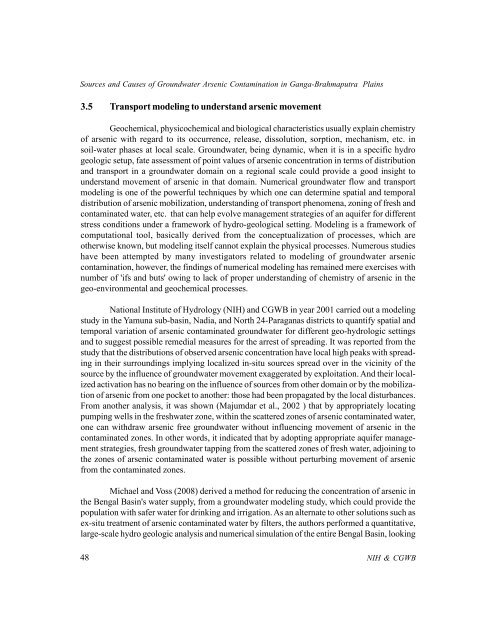Mitigation and Remedy of Groundwater Arsenic Menace in India
Mitigation and Remedy of Groundwater Arsenic Menace in India
Mitigation and Remedy of Groundwater Arsenic Menace in India
You also want an ePaper? Increase the reach of your titles
YUMPU automatically turns print PDFs into web optimized ePapers that Google loves.
Sources <strong>and</strong> Causes <strong>of</strong> <strong>Groundwater</strong> <strong>Arsenic</strong> Contam<strong>in</strong>ation <strong>in</strong> Ganga-Brahmaputra Pla<strong>in</strong>s3.5 Transport model<strong>in</strong>g to underst<strong>and</strong> arsenic movementGeochemical, physicochemical <strong>and</strong> biological characteristics usually expla<strong>in</strong> chemistry<strong>of</strong> arsenic with regard to its occurrence, release, dissolution, sorption, mechanism, etc. <strong>in</strong>soil-water phases at local scale. <strong>Groundwater</strong>, be<strong>in</strong>g dynamic, when it is <strong>in</strong> a specific hydrogeologic setup, fate assessment <strong>of</strong> po<strong>in</strong>t values <strong>of</strong> arsenic concentration <strong>in</strong> terms <strong>of</strong> distribution<strong>and</strong> transport <strong>in</strong> a groundwater doma<strong>in</strong> on a regional scale could provide a good <strong>in</strong>sight tounderst<strong>and</strong> movement <strong>of</strong> arsenic <strong>in</strong> that doma<strong>in</strong>. Numerical groundwater flow <strong>and</strong> transportmodel<strong>in</strong>g is one <strong>of</strong> the powerful techniques by which one can determ<strong>in</strong>e spatial <strong>and</strong> temporaldistribution <strong>of</strong> arsenic mobilization, underst<strong>and</strong><strong>in</strong>g <strong>of</strong> transport phenomena, zon<strong>in</strong>g <strong>of</strong> fresh <strong>and</strong>contam<strong>in</strong>ated water, etc. that can help evolve management strategies <strong>of</strong> an aquifer for differentstress conditions under a framework <strong>of</strong> hydro-geological sett<strong>in</strong>g. Model<strong>in</strong>g is a framework <strong>of</strong>computational tool, basically derived from the conceptualization <strong>of</strong> processes, which areotherwise known, but model<strong>in</strong>g itself cannot expla<strong>in</strong> the physical processes. Numerous studieshave been attempted by many <strong>in</strong>vestigators related to model<strong>in</strong>g <strong>of</strong> groundwater arseniccontam<strong>in</strong>ation, however, the f<strong>in</strong>d<strong>in</strong>gs <strong>of</strong> numerical model<strong>in</strong>g has rema<strong>in</strong>ed mere exercises withnumber <strong>of</strong> 'ifs <strong>and</strong> buts' ow<strong>in</strong>g to lack <strong>of</strong> proper underst<strong>and</strong><strong>in</strong>g <strong>of</strong> chemistry <strong>of</strong> arsenic <strong>in</strong> thegeo-environmental <strong>and</strong> geochemical processes.National Institute <strong>of</strong> Hydrology (NIH) <strong>and</strong> CGWB <strong>in</strong> year 2001 carried out a model<strong>in</strong>gstudy <strong>in</strong> the Yamuna sub-bas<strong>in</strong>, Nadia, <strong>and</strong> North 24-Paraganas districts to quantify spatial <strong>and</strong>temporal variation <strong>of</strong> arsenic contam<strong>in</strong>ated groundwater for different geo-hydrologic sett<strong>in</strong>gs<strong>and</strong> to suggest possible remedial measures for the arrest <strong>of</strong> spread<strong>in</strong>g. It was reported from thestudy that the distributions <strong>of</strong> observed arsenic concentration have local high peaks with spread<strong>in</strong>g<strong>in</strong> their surround<strong>in</strong>gs imply<strong>in</strong>g localized <strong>in</strong>-situ sources spread over <strong>in</strong> the vic<strong>in</strong>ity <strong>of</strong> thesource by the <strong>in</strong>fluence <strong>of</strong> groundwater movement exaggerated by exploitation. And their localizedactivation has no bear<strong>in</strong>g on the <strong>in</strong>fluence <strong>of</strong> sources from other doma<strong>in</strong> or by the mobilization<strong>of</strong> arsenic from one pocket to another: those had been propagated by the local disturbances.From another analysis, it was shown (Majumdar et al., 2002 ) that by appropriately locat<strong>in</strong>gpump<strong>in</strong>g wells <strong>in</strong> the freshwater zone, with<strong>in</strong> the scattered zones <strong>of</strong> arsenic contam<strong>in</strong>ated water,one can withdraw arsenic free groundwater without <strong>in</strong>fluenc<strong>in</strong>g movement <strong>of</strong> arsenic <strong>in</strong> thecontam<strong>in</strong>ated zones. In other words, it <strong>in</strong>dicated that by adopt<strong>in</strong>g appropriate aquifer managementstrategies, fresh groundwater tapp<strong>in</strong>g from the scattered zones <strong>of</strong> fresh water, adjo<strong>in</strong><strong>in</strong>g tothe zones <strong>of</strong> arsenic contam<strong>in</strong>ated water is possible without perturb<strong>in</strong>g movement <strong>of</strong> arsenicfrom the contam<strong>in</strong>ated zones.Michael <strong>and</strong> Voss (2008) derived a method for reduc<strong>in</strong>g the concentration <strong>of</strong> arsenic <strong>in</strong>the Bengal Bas<strong>in</strong>'s water supply, from a groundwater model<strong>in</strong>g study, which could provide thepopulation with safer water for dr<strong>in</strong>k<strong>in</strong>g <strong>and</strong> irrigation. As an alternate to other solutions such asex-situ treatment <strong>of</strong> arsenic contam<strong>in</strong>ated water by filters, the authors performed a quantitative,large-scale hydro geologic analysis <strong>and</strong> numerical simulation <strong>of</strong> the entire Bengal Bas<strong>in</strong>, look<strong>in</strong>g48NIH & CGWB




